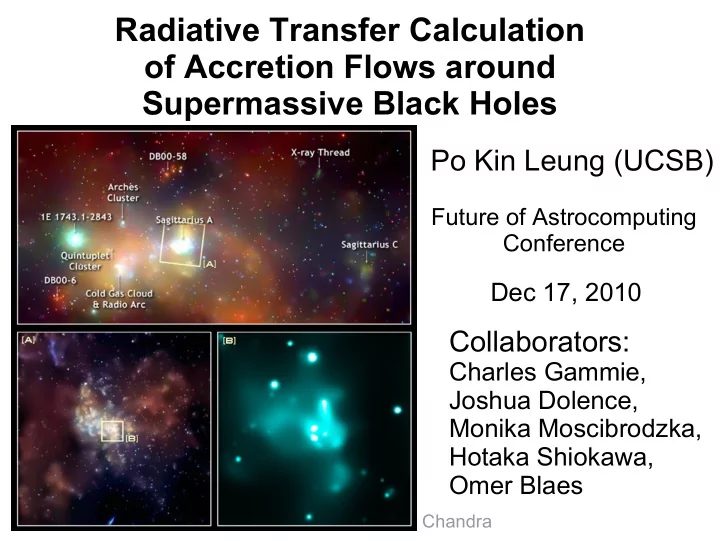

Radiative Transfer Calculation of Accretion Flows around Supermassive Black Holes Po Kin Leung (UCSB) Future of Astrocomputing Conference Dec 17, 2010 Collaborators: Charles Gammie, Joshua Dolence, Monika Moscibrodzka, Hotaka Shiokawa, Omer Blaes Chandra
● Stars around Sgr A* ● Supermassive BH M BH » 4 £ 10 6 M ¯ ● Broadband spectrum observed L » 10 ¡ 9 L edd ● Low Luminosity AGNs ● Accretion disk around supermassive BH ● Radiatively Inefficient Accretion Flow (RIAF)
Disk Model (HARM 2D: Gammie et al. 03, 3D: Noble et al. 06, 09) + Emission (harmony: Leung et al. 09) + Radiative Transfer (bothros: Noble et al. 09, grmonty: Dolence et al. 09) = image , spectrum HARM 2D (Gammie et al. 03) Moscibrodzka et al. 09
Flaring events ● NIR flares occur ~4 times/day, X-ray flares occur ~1 times/day ● X-ray flare must come with NIR flare, not vice versa ● NIR flares are highly polarized ● Strong NIR flares have spectral slope » 0 : 4 § 0 : 2 (Hornstein et al. 2007) ● Spectral slope of X-ray flares is less certain
Adding non-thermal electrons ● Power-law distribution with single index n nth ( ° ) / ° ¡ p for ° min · ° · ° max ● Either use X-ray flares as upper limit, or fit them ● Parameters are p; ° min ; ° max ; ´ ´ u nth =u th Leung et al., in prep.
Degeneracy of parameters
Conclusions ● GRMHD and RT simulations of accretion disk around black hole ● Consider non-thermal electrons for flaring event ● Degeneracy of parameters ● Take-home message: Positive spectral slope observed in strong NIR flares of Sgr A* can be explained by synchrotron emission of small amount of non-thermal electrons Thank you!
Recommend
More recommend